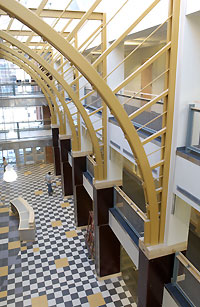|
This is an archived article.
For the latest news, go to the
Advance Homepage
For more archives, go to the Advance Archive/Search Page. | ||||
|
Undergraduate Education Center
Keith Barker wanted to see for himself. So, one day last fall, he made the trek from the offices of the Study Abroad Program, located in the Human Development and Family Relations Building off Bolton Road, to the offices of the Academic Center for Entering Students (ACES), on the first floor of a residence hall in Northwest campus. The walk took 25 minutes.
Today, as the new semester begins, the distance between the two student-centered programs is two floors and a quick walk down the hall of the building that formerly housed the School of Business. From now on, the building's business will be the business of learning - for students, faculty, and teaching assistants. Whereas the mission of staff in the Wilbur Cross Building is to take care of the administrative aspects of students' lives, the mission of the 100 or so people now housed in the Center for Undergraduate Education is teaching and learning. The CUE, like Wilbur Cross, offers students and faculty one-stop shopping. "Can you imagine telling a student asking for help that he or she has to go to another office, one that's 25 minutes away? The odds that the student will go are close to nil," says Barker, an associate vice provost and director of the Institute for Teaching and Learning. "The CUE will provide all the support for undergraduate education that any student will need that's not in Wilbur Cross. It also offers support services for teaching assistants and all the support necessary for faculty development." To accommodate the myriad academic services - 19 separate departments now call the CUE home - the main building was renovated and reconfigured and a 19,000-square-foot addition was built adjacent to the structure, at a cost of about $11 million. The two parts of the building are connected by two sets of bridges - one each on the second and third floors - that stretch across an atrium. The bridges and walkways on each side are lit by glass ceilings, and look down on a wide corridor that spans the length of the building. "I think all members of the Division of Undergraduate Education are very pleased to have a home for all our units and programs," says Fred Maryanski, senior vice provost for academic affairs. "There are tremendous benefits to having everything in one place, and I hope and believe we'll see many, many students taking advantage of those services." Steve Jarvi, assistant vice provost and director of the Institute for Student Success, says the building "creates great synergy. It brings all these functions together that share a common goal of helping students succeed: advisors, the Honors Program, First Year Experience, Student Support Services. Career Services, too. They're not technically under the academic rubric, but they help students succeed as they move on."
Faculty, of course, are also key to helping students succeed, and they are also included in the center. Much of the third floor is dedicated to teaching and faculty development, including a classroom with a video camera for training instructors who are new or seeking a refresher. Barker's Institute for Teaching and Learning is based on the same floor, as is the Instructional Resource Center, and the office of Instructional Design and Faculty Development, which helps faculty prepare curricula. There are also two high-tech classrooms designed for distance learning on the floor, and offices for the Study Abroad Program and for individualized majors. The fourth floor is occupied primarily by the University Center for Instructional Media and Technology (UCIMT). The Honors Program also is located on the fourth floor. "This is a tremendous asset for our students," says Dolan Evanovich, vice provost for enrollment management. "It's a great improvement to our academic service delivery, and I think the students will be really pleased with how well it works." Evanovich says bundling the services may also help improve the undergraduate retention and graduation rates. Currently, 88 percent of UConn freshmen return for their sophomore year, and 70 percent of UConn students graduate within six years. Although these rates compare favorably with those of UConn's peer institutions, according to U.S. News & World Report, America's Best Colleges 2004, the University aspires to raise them further. The graduation rate for minority students increased from 62 percent in 2002 to 69 percent in spring 2003, a rate that could place UConn among the top 10 public universities nationally. |


